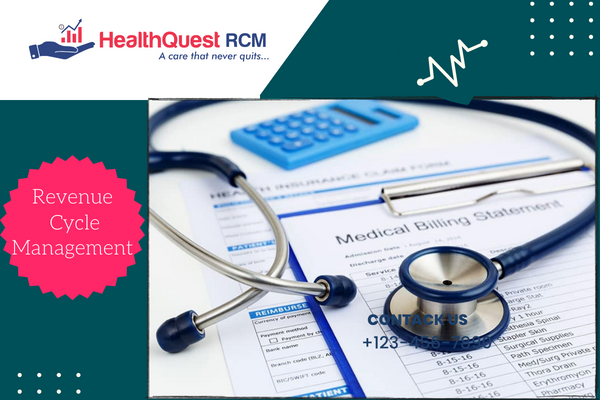Revenue Cycle Management – Why Every Healthcare provider is taking it more seriously than ever?
What’s the first thing that strikes your mind once you hear the term ‘Revenue Cycle management’? While it may sound like a typical business management function, it covers a myriad of domains and industries.
In a layman’s language, we can define revenue cycle management as a strategy that healthcare providers can employ to manage the administrative and clinical aspects of their revenue cycle. The moment a patient contacts the healthcare provider to make an appointment, the revenue cycle starts. Moreover, once all payments have been received for the consultation and therapy, the cycle can be termed as ‘over’.
On the other side, the purpose of revenue cycle management is to locate and address any points of friction in the provider’s revenue cycle. Doing that, healthcare providers can maximize their claim reimbursements and raise their revenue in the long run.

Functioning of Healthcare Revenue Cycle Management
Revenue cycle isn’t just a single function and it brings over several entities to play at the same time. Besides, there are numerous steps in the revenue cycle for healthcare. Well, this indicates that there are numerous opportunities for mistakes to happen and any errors in the revenue cycle have the potential to stall or delay the provider’s ability to get paid by patients and insurers.
That said; let’s look at the steps in the healthcare revenue cycle to get a better idea of where errors can happen and how RCM can prevent them:
Pre-authorization and eligibility verification – The healthcare provider gathers data to create a patient account when a patient schedules an appointment. This involves gathering the patient’s insurance details and confirming their eligibility for coverage.
Even if a patient already has an account with the provider, revenue cycle management company places a strong emphasis on accurately completing this step. A claim denial later in the revenue cycle will only be the result of inaccurate information or ineligible insurance. This indicates a delay in the reimbursement payment to the provider. Additionally, it adds to the provider’s workload because they must go over the patient’s records again to fix the mistakes.
Charge capturing and coding: Using generally recognized medical codes, charge capturing converts patient services into billable charges. That said, insurance companies use these codes to calculate reimbursement amounts.
The insurance provider might reject the patient’s claim if the medical records are not properly coded. As a result, provider reimbursement is delayed. Additionally, it costs the provider time and money because appeals and investigations are required for denied claims. Coding accuracy is ensured by effective revenue cycle management company in texas, allowing denials to be completely avoided.
Submission of claims – Following accurate coding of a patient’s treatment, a claim is submitted to the insurance provider for approval. RCM manages and tracks the claim from the outset of the process to ensure that it is submitted as soon as possible.
Payment collection – After the insurance company has granted the patient’s claim, the provider is paid according to the patient’s eligibility. The provider must contact the patient to obtain any unpaid balance if there is any after the insurance company has paid its share.
So, technically, revenue cycle management streamlines claims processing to hasten this patient payment process. Additionally, patients will be aware of their initial out-of-pocket costs thanks to the increased emphasis RCM places on front-end tasks like confirming insurance eligibility. By doing so, providers can prevent any hiccups during the collection of the last payment.
Review of medical services – Care providers are encouraged to analyze clinical treatment data by comprehensive revenue cycle management. By analyzing this data, providers can pinpoint the key points in the cycle where mistakes are occurring and find opportunities to reduce costs. As a result, this will boost provider income and enhance the patient experience.
What are the key benefits of Revenue Cycle management?
To help providers avoid delayed or lost revenue, effective revenue cycle management makes sure that these steps are carried out completely and accurately.
Detecting and Correcting Errors
Healthcare providers can more easily spot where errors are happening in the revenue cycle by implementing RCM. This reduces the possibility of claim denials since 90% of claim denials are brought on by easily fixable technical problems, such as missing data from the patient’s chart or incorrect coding.
When these mistakes are prevented and claims are accepted after their initial submission, providers quickly get paid for their services. Additionally, they don’t have to spend additional funds on research or an appeal of rejected claims.
Reducing Administrative burden
Keeping claim denials to a minimum also reduces the administrative burden. More time and energy can be devoted to patient care when administrative staff members are relieved of the burden of investigating and appealing denied claims.
Additionally, interactions between administrative staff and patients are made simpler by RCM’s careful attention to front-end tasks. For a better overall experience, appointment scheduling, intake form completion, and payment processing are all streamlined.
Keeping Healthcare Fraud at Bay
The prevention of healthcare fraud and abuse is another important advantage of RCM. Every year, healthcare fraud costs the sector billions of dollars. A provider may lose revenue and reputation as a result of a fraud investigation.
Healthcare fraud investigations may result from incorrect medical coding, whether it was done on purpose or not. Among the frequent coding mistakes are billing for:
- Non-performance of services
- Medically pointless actions
- Services rendered by a worker who wasn’t properly supervised or wasn’t qualified
- Poor quality tests or procedures
Providers are much less likely to submit inaccurate information to insurance companies (if at all), thanks to revenue cycle management’s focus on precise data collection, billing, and coding. Additionally, RCM can keep providers abreast of constantly evolving healthcare regulations so that unintentional fraud never becomes a problem.
Medical fraud
Healthcare fraud can also come from dishonest patients. This may occur in one of two ways:
Giving false information – A patient may give false information about their insurance coverage in order to receive treatment for which they would not otherwise be eligible. However, one of the initial steps in revenue cycle management is insurance verification. This implies that administrative staff will immediately notice any incorrect insurance information.
Committing medical identity theft – The healthcare sector is increasingly concerned about medical identity theft. This way, both its victims and its providers pay a price. Since the first step in revenue cycle management is to confirm a patient’s information, any identity theft will be identified and dealt with early on.
During the pre-authorization stage of the revenue cycle, medical providers can also take additional steps to confirm a patient’s identity.
Increasing the revenue of healthcare facilities
Healthcare providers can quickly get paid for their services by avoiding technical errors, claim denials, and fraud investigations. Additionally, they can avoid shelling out thousands of dollars to fix mistakes, contest claims, and look into fraud. Moreover, providers are able to make investments in patient care thanks to their increased income.
Final words
The patient comes first in RCM’s effort to increase provider revenue for all parties. Besides, revenue cycle management company in taxes reduces the amount of time needed for administrative and clinical tasks while increasing provider revenue.

